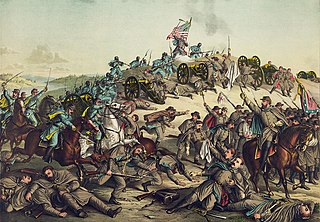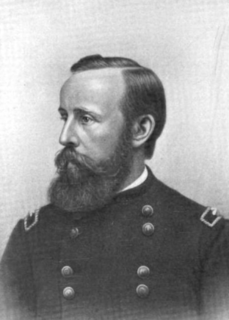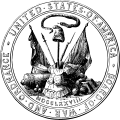
Ambrose Everett Burnside was a Union soldier, railroad executive, inventor, industrialist, and politician from Rhode Island. He served as the Governor of Rhode Island from 1866 to 1869, and as a United States Senator for Rhode Island from 1875 until his death.

The Army of the Potomac was the principal Union Army in the Eastern Theater of the American Civil War. It was created in July 1861 shortly after the First Battle of Bull Run and was disbanded in June 1865 following the surrender of the Confederate Army of Northern Virginia in April.

The SecondBattle of Franklin was fought on November 30, 1864, in Franklin, Tennessee, as part of the Franklin–Nashville Campaign of the American Civil War. It was one of the worst disasters of the war for the Confederate States Army. Confederate Lt. Gen. John Bell Hood's Army of Tennessee conducted numerous frontal assaults against fortified positions occupied by the Union forces under Maj. Gen. John Schofield and was unable to prevent Schofield from executing a planned, orderly withdrawal to Nashville.

The Battle of Nashville was a two-day battle in the Franklin-Nashville Campaign that represented the end of large-scale fighting west of the coastal states in the American Civil War. It was fought at Nashville, Tennessee, on December 15–16, 1864, between the Confederate Army of Tennessee under Lieutenant General John Bell Hood and the Union Army of the Cumberland under Major General George H. Thomas. In one of the largest victories achieved by the Union Army during the war, Thomas attacked and routed Hood's army, largely destroying it as an effective fighting force.

The Army of the Cumberland was one of the principal Union armies in the Western Theater during the American Civil War. It was originally known as the Army of the Ohio.
The Army of Georgia was a Union army that constituted the Left Wing of Major General William T. Sherman's Army Group during the March to the Sea and the Carolinas Campaign.
The Army of the Ohio was the name of two Union armies in the American Civil War. The first army became the Army of the Cumberland and the second army was created in 1863.
IX Corps was a corps of the Union Army during the American Civil War that distinguished itself in combat in multiple theaters: the Carolinas, Virginia, Kentucky, Tennessee, and Mississippi.

The XVI Army Corps was a corps of the Union Army during the American Civil War. The corps rarely fought as one unified unit, as its divisions were often scattered across the country.

The 104th Ohio Infantry Regiment, sometimes 104th Ohio Volunteer Infantry was an infantry regiment in the Union army during the American Civil War. It played a conspicuous role at the Battle of Franklin during the 1864 Franklin-Nashville Campaign, where six members later received the Medal of Honor, most for capturing enemy flags.

The Knoxville campaign was a series of American Civil War battles and maneuvers in East Tennessee during the fall of 1863 designed to secure control of the city of Knoxville and with it the railroad that linked the Confederacy east and west, and position the First Corps under Longstreet for return to the Army of Northern Virginia. Union Army forces under Maj. Gen. Ambrose Burnside occupied Knoxville, Tennessee, and Confederate States Army forces under Lt. Gen. James Longstreet were detached from Gen. Braxton Bragg's Army of Tennessee at Chattanooga to prevent Burnside's reinforcement of the besieged Federal forces there. Ultimately, Longstreet's own siege of Knoxville ended when Union Maj. Gen. William Tecumseh Sherman led elements of the Army of the Tennessee and other troops to Burnside's relief after Union troops had broken the Confederate siege of Chattanooga. Although Longstreet was one of Gen. Robert E. Lee's best corps commanders in the East in the Army of Northern Virginia, he was unsuccessful in his attempt to penetrate the Knoxville defenses and take the city.

Nathaniel Collins McLean, was a lawyer, farmer, and Union general during the American Civil War. He was appointed colonel of the 75th Ohio Infantry Regiment in 1861 and led the regiment in several battles before commanding a brigade. During the Second Battle of Bull Run, his brigade's determined defense of Chinn Ridge probably saved the Union Army from a disaster. He led a brigade at the Battle of Chancellorsville in 1863, for a month in the Atlanta campaign in 1864, and in the Carolina campaign in 1865. After the war, he returned to his law practice in Cincinnati, moved to Minnesota, and moved again to New York where he died.

John Grant Mitchell was an Ohio lawyer and a general in the Union Army during the American Civil War. He was active in several important campaigns and battles in the Western Theater, including the Chickamauga, Atlanta, and Franklin-Nashville and Carolinas campaigns. He commanded a brigade of veteran infantry in many of these operations.
James William Reilly was a lawyer, politician, and soldier from the state of Ohio who served as a general in the Union Army during the American Civil War. He commanded a brigade and then a division in the Army of the Ohio in several campaigns in the Western Theater of operations.
The 12th Kentucky Infantry Regiment was an infantry regiment that served in the Union Army during the American Civil War.
The 16th Kentucky Infantry Regiment was an infantry regiment that served in the Union Army during the American Civil War.

Edward Harland was a Union general during the American Civil War. He was associated with early battles of the IX Corps as well as Union involvement in North Carolina and the Tidewater region of Virginia.
15th Indiana Battery Light Artillery was an artillery battery that served in the Union Army during the American Civil War.
The 107th Illinois Volunteer Infantry Regiment was raised as part of the call for 300,000 volunteers in the summer and fall of 1862. It was organized on September 4, 1862, at Camp Butler near Springfield, Illinois, and was composed of men from DeWitt, Piatt, and Williamson Counties in central and southern Illinois.
The 51st Pennsylvania Volunteer Infantry was an infantry regiment that served in the Union Army during the American Civil War.
















